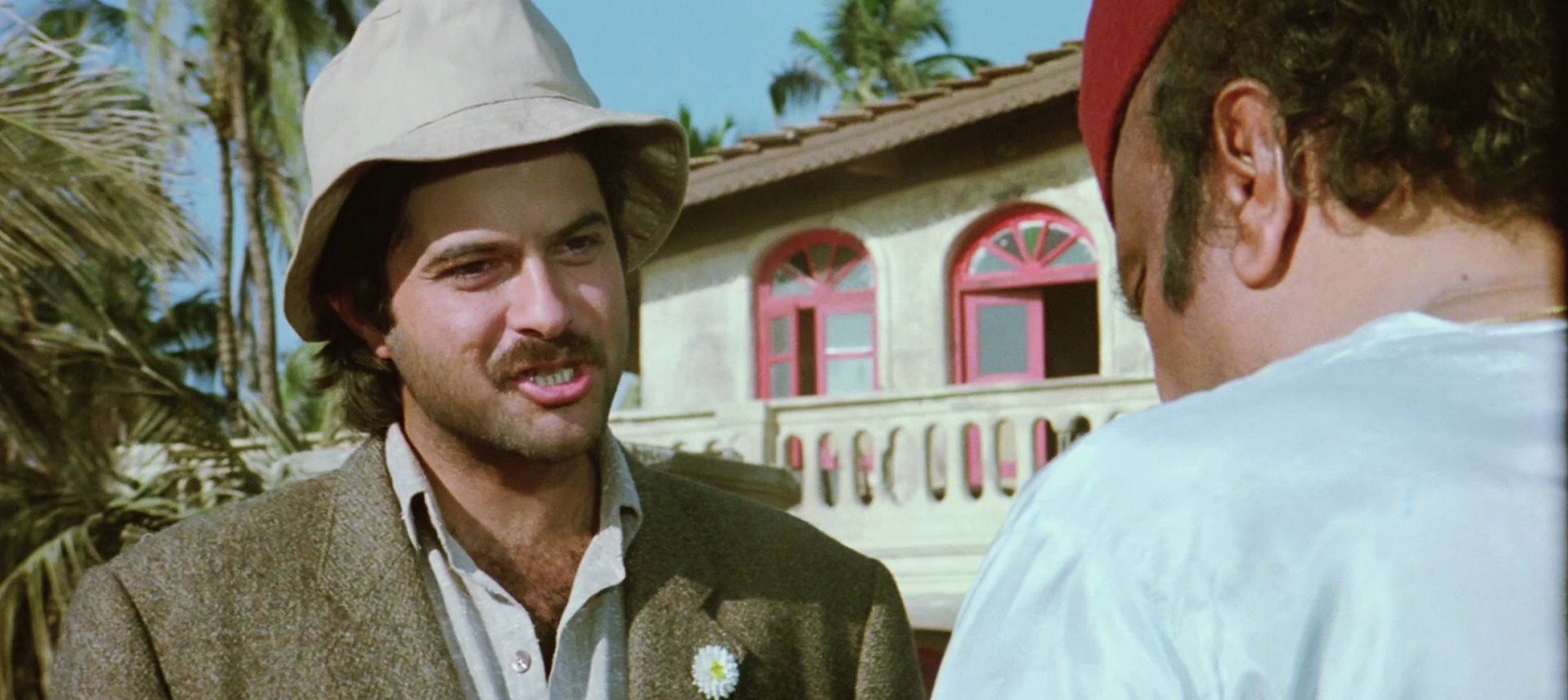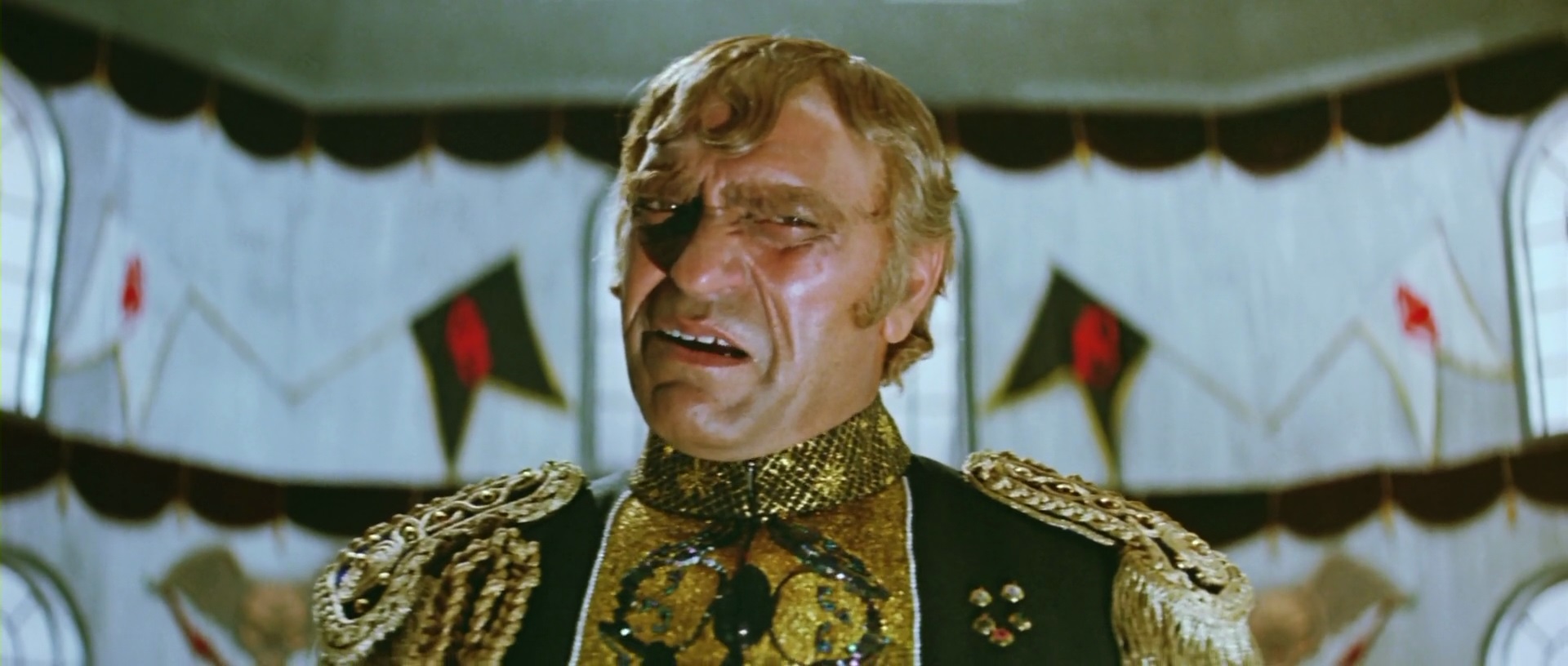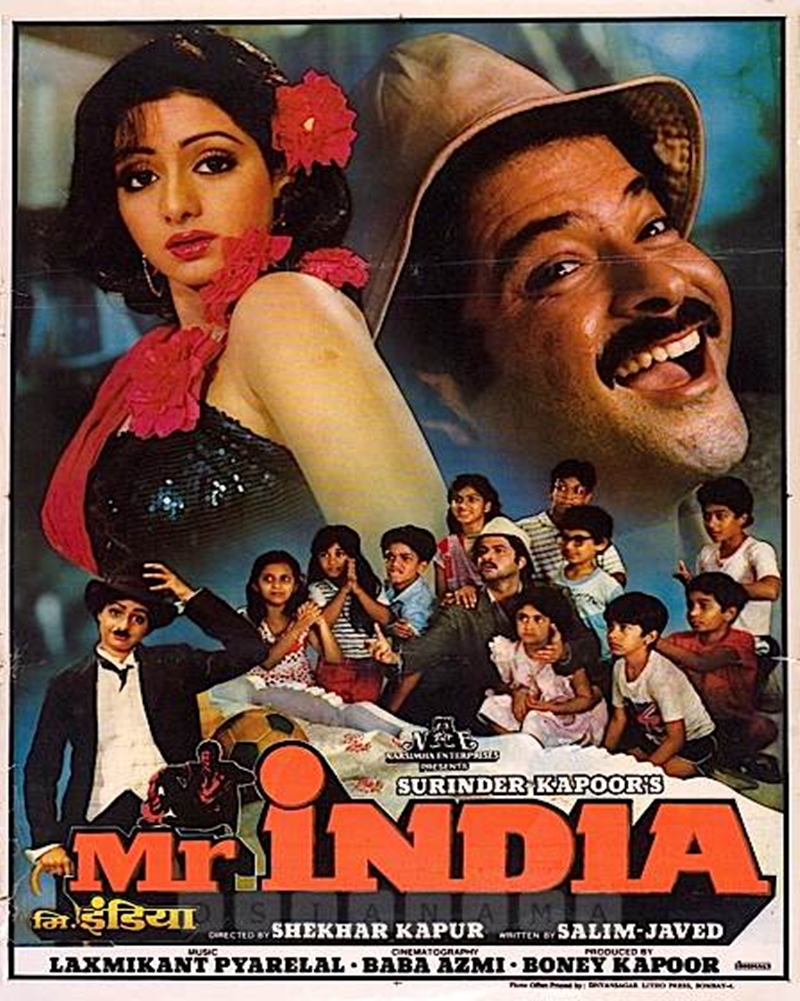India. 1987.
Crew
Director – Shekhar Kapur, Screenplay – Salim Javed, Producer – Boney Kapoor, Photography – Baba Azmi, Music – Laxmikant Pyarelal, Lyrics – Javed Akhtar, Special Effects Supervisor – Peter Pereira, Mechanical Effects – Arun Patil, Art Direction – Bijon Das Gupta. Production Company – Narsimha Enterprises.
Cast
Anil Kapoor (Arun Varma), Sridevi (Seema), Amrish Puri (Mogambo), Satish Kaushik (Calendar), Annu Kapoor (Mr Gaitonde), Harish Patel (Roopchand), Sharat Saxena (Daga), Ajit Vachani (Teja), Ashok Kumar (Professor Sinha)
Plot
The power-crazed Mogambo desires to conquer India. In Bombay, the poor music tutor Arun Varma looks after a household of orphan children but is well behind on paying his rent and grocery bill. Mogambo’s henchmen want Arun’s house to run their rackets out of and have Arun’s landlord demand that his rent be paid in full in an effort to evict him. Arun decides the only solution is for him to take in a boarder. He goes to place an ad in the local newspaper but the reporter Seema mistakes him for an interviewee. When she learns that he has a room for rent, she accepts, desiring to get away from her current lodgings where noisy children are preventing her from working. Arun tries to hide the orphans from her and there are fireworks when she discovers them. Arun is however able to pay his back rent. Mogambo’s men then cut off his line of credit with the grocer and the children are left starving but Seema comes to their aid. Arun then learns about a formula created by his late scientist father and discovers a wristband device that can make the wearer invisible. Seema goes undercover as a singer to find out information about Mogambo’s gangs and is captured but Arun uses the wristband and is able to save her. When she asks who her invisible saviour is, Arun says that his name is Mr India and that he has come to stand up for ordinary Indians. As Mr India, Arun is able to stop many of Mogambo’s criminal operations and is soon regarded as a national hero. Seema announces she in love with Mr India, although as Arun he ridicules the notion of any invisible man. Mogambo then decides to crush Mr India by taking Arun, Seema and the children prisoner and launching missiles on India.
Indian or Bollywood cinema is unique and quite unlike any other Western film-going experience. For people who are used to Hollywood filmmaking, Bollywood films are something entirely different – Indian films are rarely under two hours in length; they come made to a certain formula that always manages to wind in several singing and dancing numbers no matter what genre is being covered – romance, action or thriller; and there is always a strong romantic element, even though Indian censorship strictures forbid the portrayal of kissing on screen, resulting in a good deal of implied sensuality.
Despite being the largest film producing country in the world, films covered by this site – science-fiction, horror and fantasy – are somewhat of a rarity in India. Mr India, one exception, is a Bollywood superhero film – indeed, it was one of a minor spate of Bollywood superhero films that came out around the same, which also included the likes of Shiva Ka Insaaf (1985) and The Indian Superman (1987). There have been only sporadic Bollyood superhero films since with the likes of Endhiran (2010) and the gritty masked vigilante film Bhavesh Joshi Superhero (2018),
Of course, Mr India is quite unlike anything that a Westerner might recognise as a standard Hollywood superhero film or tv series. For one this is a superhero film that comes with singing/dancing interludes, while there is also a strong element of slapstick comedy and lots of cutsie scenes involving a retinue of kids. If anything, what Mr India resembles is a combination of a 1970s Disney live-action children’s film or a Little Rascals comedy and one of the cheap Italian-made Bud Spencer-Terence Hill slapstick comedies.
Mr India should be seen for the completely lunatic entertainment value it provides. There is a great deal of frenetically silly slapstick between hero Anil Kapoor, heroine Sridevi and the kids. Indeed the various slapstick, comedic and singing-dancing happenings between all of them takes up more than an hour of the film’s running time before we get to the introduction of the invisibility device.

All the invisibility sequences are played with slapstick percussive sound effects – whistling and clonking noises – laid over the top. (Mr India is made on a low budget and there are surprisingly few in the way of invisibility special effects throughout). The climax involves the kids riding into the villain’s control room on dinner carts and defeating his armed soldiers with thrown metal plates and spray cans. The silliest sequence in the film is the one set in a casino, which for some reason involves the heroine entering dressed as Charlie Chaplin and turns into a Keystone Kops sequence with everybody running around in sped-up motion, falling the length of tables and bars, being invisibly thrown and so forth.
There are several singing and dancing interludes throughout. There are songs set to montages of Anil Kapoor and the kids dancing through the streets and woods, taking a ferry trip and driving in a yellow Jeep, with him playing the flute and violin and everybody waving wildly; or he and the heroine running down the beach whacking each other with cricket bats and she serving him tea as he reads a newspaper on a chair in the middle of a field. There is an immensely entertaining song and dance number about Sridevi refusing to give back the kid’s soccer ball after it hits her on the head, which comes with much pouting on her part and lots of sung pleas from the houseful of dancing kids, while the song itself is apparently a medley composed from popular songs and given new lyrics. The Miss Hawahawai sequence is a highly energetic number, in good part due to the comic playing of Sridevi, who for wholly surreal reason is surrounded by a chorus in all painted brownface like something out of a Black and White Minstrel Show.
The song numbers are undeniably catchy – in particular one that takes place on a set surrounded by flowing fountains with the heroine singing about how she loves Mr India, which has Anil Kapoor popping in and out of visibility, before in all the implied sensuality of Bollywood cinema, she rolls around on hay while she chews a stalk in her mouth with absurd suggestiveness. At nearly three hours in length, Mr India is way too long by Hollywood standards – and certainly has an exceedingly slim plot for something that is required to fill that length of time – but all the banal and manically happy nuttiness makes for an undeniably likeable show.

One of the most entertaining aspects of the film is the performance from Amrish Puri as the villain Mogambo. Amrish Puri is the only cast name likely to be known to English-speaking audiences – he played the high priest in Indiana Jones and the Temple of Doom (1984). His lair has been decked out as a B-budget version of a James Bond villain’s hideout, and he comes across as a serial-styled villain in boots and gilted costume and has a series of henchmen named Dr Fu Manchu, Dr Watson and Captain Zorro. Puri plays to the gallery with thoroughly entertaining regard – his leering grins to the camera, “Mogambo khush huaa [Mogambo is pleased]” – are hysterical.
Director Shekhar Kapur also piles on the sentiment. The scenes with the kids starving come in completely over-the-top straight-face – the images of hero Anil Kapoor anguishing over being unable to do anything and the roomful of starving children is played with maudlin theatricality. Equally absurd are the manically happy feelgood solutions that the film offers for dealing with the children’s imminent starvation – which is for them to surround Anil Kapoor singing songs about hope and how things will be better tomorrow. The score is equally overblown, alternating between overly florid cues copied from Hollywood epics and standard comic effect.
Mr India has an undeniable political element to it as well. Mogambo is seen as a foreign invader (from where he comes is never specified – he has blonde hair but Indian features), while one of the secondary villains is said to be British. It is Mogambo’s stated plan to conquer India by setting the disparate ethnic and religious elements against one another (although in practice Mogambo never seems to be doing much more than running standard racketeering schemes). Mr India is seen to embody an interesting metaphor – his name being taken so as to represent the “ordinary Indian”.
In this respect, Mr India has many similarities to some of the American-made Black superhero films – The Meteor Man (1993), Blankman (1994) and Pootie Tang in “Sine Your Pitty on the Runy Kine” (2001) – where the superhero becomes a symbol of empowerment for an oppressed minority. Here Mr India pointedly stands up to take issue with moneylenders, Mafia and merchants who cut grain with stones (which one gets the impression is a widespread practice in India). He even makes the hoods trying to steal a gold idol bow down and pay obeisance to it, and in one pointed scene invisibly carries a laden banquet table from where a hood and his girlfriend are dining and gives it to the starving poor outside. Of course, by his very name, Mr India, the character is seen to embody a sense of Indian patriotism is standing up against the ills of society, which are notedly blamed on outside (foreign) malice.
(Review copy provided courtesy of Suresh S).
Trailer here


